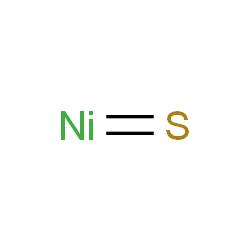Nickel(II) Sulfide
Modify Date: 2024-01-01 19:07:32

Nickel(II) Sulfide structure
|
Common Name | Nickel(II) Sulfide | ||
|---|---|---|---|---|
| CAS Number | 16812-54-7 | Molecular Weight | 90.758 | |
| Density | 5.3 g/cm3 | Boiling Point | N/A | |
| Molecular Formula | NiS | Melting Point | 797ºC | |
| MSDS | N/A | Flash Point | N/A | |
| Name | Nickel(II) Sulfide |
|---|---|
| Synonym | More Synonyms |
| Density | 5.3 g/cm3 |
|---|---|
| Melting Point | 797ºC |
| Molecular Formula | NiS |
| Molecular Weight | 90.758 |
| Exact Mass | 89.907417 |
| PSA | 25.30000 |
| Appearance of Characters | Powder |
| Vapour Pressure | 12600mmHg at 25°C |
| Water Solubility | 0.00036g/100mL H2O (18°C) [CRC10] |
|
Section 1: Product Identification Chemical Name:Nickel (II) sulfide (99.9%-Ni) CAS Registry Number:16812-54-7 Formula:Ni3S2/NiS EINECS Number:240-841-2 Chemical Family:metal chalcogenides Synonym:Nickel monosulfide
Section 2: Composition and Information on Ingredients IngredientCAS NumberPercentACGIH (TWA)OSHA (PEL) Title Compound16812-54-7100%0.2mg/m31mg/m3 Section 3: Hazards Identification Irritating to skin, eyes and respiratory tract. May cause sensitization by skin contact. May cause cancer by Emergency Overview: inhalation. Primary Routes of Exposure:Ingestion, inhalation, skin and eyes Eye Contact:Dust causes moderate irritation of the eyes. Skin Contact:Causes slight irritation of the skin. Prolonged contact with nickel salts may lead to dermatitis. Inhalation:Inhalation of dust will lead to irritation of the respiratory tract. May cause cancer by inhalation. Gastric juices may cause release of toxic hydrogen sulfide, causing, nausea, dizziness, pulmonary edema, Ingestion: death. Acute Health Affects:Irritating to skin, eyes and respiratory tract. May cause sensitization by skin contact. Long term exposure to nickel and nickel compounds may lead to skin irritation and dermatitis. May cause Chronic Health Affects: cancer. NTP:Yes IARC:Yes OSHA:No SECTION 4: First Aid Measures Immediately flush the eyes with copious amounts of water for at least 10-15 minutes. A victim may need Eye Exposure: assistance in keeping their eye lids open. Get immediate medical attention. Wash the affected area with water. Remove contaminated clothes if necessary. Seek medical assistance if Skin Exposure: irritation persists. Remove the victim to fresh air. Closely monitor the victim for signs of respiratory problems, such as difficulty Inhalation: in breathing, coughing, wheezing, or pain. In such cases seek immediate medical assistance. Seek medical attention immediately. Keep the victim calm. Give the victim water (only if conscious). Induce Ingestion: vomiting only if directed by medical personnel. SECTION 5: Fire Fighting Measures Flash Point:not applicable Autoignition Temperature:no data Explosion Limits:no data Extinguishing Medium:carbon dioxide or dry powder If this product is involved in a fire, fire fighters should be equipped with a NIOSH approved positive pressure Special Fire Fighting Procedures: self- contained breathing apparatus and full protective clothing. Hazardous Combustion andIf involved in a fire this material may emit irritating fumes of hydrogen sulfide and sulfur dioxide. Decomposion Products: Dust may form explosive mixtures with air. Contact with acids gives off hydrogen sulfide, a toxic and Unusual Fire or Explosion Hazards: flammable gas. SECTION 6: Accidental Release Measures In the case of a spill, the fine powder should be covered with dry sodium carbonate or dolomite in order to Spill and Leak Procedures: reduce the formation of dust. Sweep up the mixture. SECTION 7: Handling and Storage Store in a tightly sealed container. Exposure to the atmosphere may lead to release of toxic hydrogen sulfide Handling and Storage: gas. Empty containers may retain product residues that evolve toxic gases. SECTION 8: Exposure Controls and Personal Protection Eye Protection:Always wear approved safety glasses when handling a chemical substance in the laboratory. Skin Protection:Wear appropriate chemical resistant gloves and protective clothing. Ventilation:If possible, handle the material in an efficient fume hood. If ventilation is not available a respirator should be worn. The use of a respirators requires a Respirator Respirator: Protection Program to be in compliance with 29 CFR 1910.134. Ventilation:If possible, handle the material in an efficient fume hood. Additional Protection:No additional protection required. SECTION 9: Physical and Chemical Properties Color and Form:-200 mesh black pwdr. Molecular Weight:not applicable Melting Point:797° Boiling Point:no data Vapor Pressure:not applicable Specific Gravity:5.3-5.65 Odor:none Solubility in Water:insoluble SECTION 10: Stability and Reactivity Stability:air and moisture stable Hazardous Polymerization:no hazardous polymerization Conditions to Avoid:Contact of dust cloud with an ignition source. Incompatibility:none Decomposition Products:hydrogen sulfide, sulfur dioxide, and metal oxides. SECTION 11: Toxicological Information RTECS Data:No specific information available on this product. Carcinogenic Effects:Tumorigen Mutagenic Effects:no data Tetratogenic Effects:no data SECTION 12: Ecological Information Ecological Information:No information available SECTION 13: Disposal Considerations Disposal:Dispose of according to local, state and federal regulations. SECTION 14: Transportation Shipping Name (CFR):Non-hazardous Hazard Class (CFR):NA Additional Hazard Class (CFR):NA Packaging Group (CFR):NA UN ID Number (CFR):NA Shipping Name (IATA):Non-hazardous Hazard Class (IATA):NA Additional Hazard Class (IATA):NA Packaging Group (IATA):NA UN ID Number (IATA):NA SECTION 15: Regulatory Information TSCA:Listed in the TSCA inventory. SARA (Title 313):Title compound: see category code N495 for reporting. Second Ingredient:none SECTION 16 - ADDITIONAL INFORMATION N/A |
CHEMICAL IDENTIFICATION
|
| Hazard Codes | T,N |
|---|---|
| Risk Phrases | 43-49-50/53 |
| Safety Phrases | 53-45-61 |
| RIDADR | UN 2811 |
| EINECS 240-841-2 |
| MFCD00016266 |
| nickel sulfide |
| Nickel, thioxo- |
| Thioxonickel |